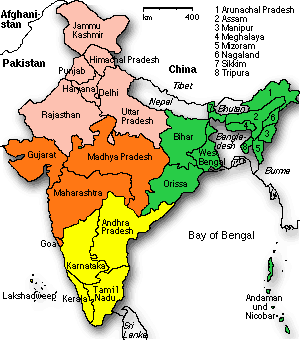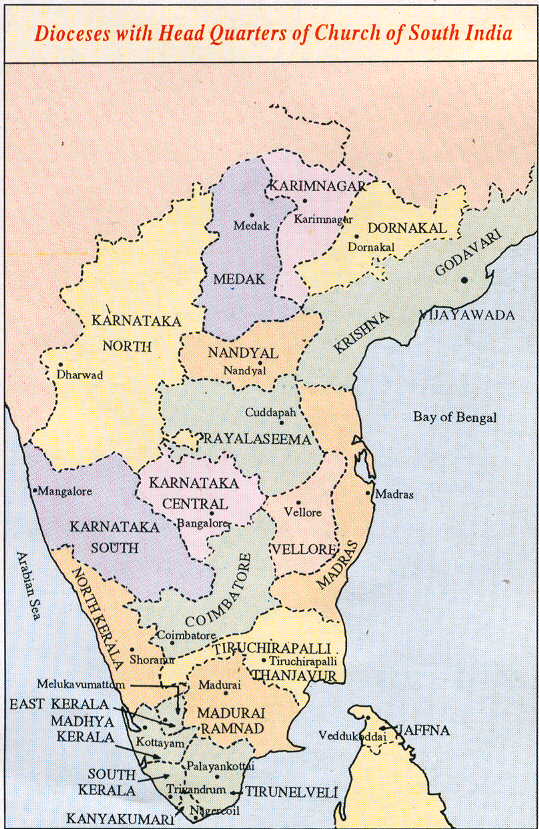|
History Of Church Of South India |
||
| Home / About Us | ||
|
Church of South India
(a) History When the Church of
South India (CSI) was inaugurated on 27th September 1947,
it was acclaimed as the most significant event in the Church Union movement,
because for the first time after centuries of historic divisions, churches
with Episcopal and non Episcopal ministries were brought together in a
united Episcopal church. Four different church traditions had been brought
together in the CSI, Anglican (Episcopal),
Congregational, Presbyterian and Methodist. All these churches had been
established in India through the missionary work of churches in Europe,
America and Australia, who had started their work in India at different
periods from the beginning of the eighteenth century. The Anglican Church was established through the work
of the Church Missionary Society (CMS) and the Society for the Propagation of
the Gospel (SPG), both closely linked with the Church of England. The
congregational churches were established through the missionary activities
of the London Missionary with missionaries from Great Britain and Australia,
and the American Board of Commissioners of foreign Missions (ABCFM) ). The
Presbyterian Churches through the work of the Church of Scotland Mission, the
Dutch Reformed Church in America and the Basel Mission in Switzerland and
Germany. They also had Connections with the Presbyterian Churches in England
and Australia. The Methodist Church was established by the Methodist
Missionary Society of the Methodist Church in Great Biitain. With
the growth of nationalism
during the latter part of the 19th century, there developed among Indian
Christians also a concern for self-reliance and independence. There was
further the growing awareness that the divisions among the churches in India
were not the making of Christians in India, but brought by the different
missions from abroad. Several efforts were made to bring about a united,
indigenous Christian church in India free from dependence on denominational
links with churches in the west. None of these had lasting results. However, faced with the challenge of the mission
frontier and the necessity of better credibility, the churches themselves
began to be increasingly aware of the scandal of disunity and sought ways of
overcoming it. As a result, different kinds of mergers or unions among
churches were beginning to take place. In October 1901, a Federal Union took
place between the Presbyterian missions in South India, the United Free Church
of Scotland Mission, the American Arcot Mission of the American Dutch Reformed
Church and the Base] Mission. In 1904, the Congregational churches of the
London Missionary Society in South India and the Congregational churches of
the American Board Missions in South India and Jaffna came together in a
Federal Union. In 1908, these two bodies, the Presbyterian and the
Congregational, came together to form the South India United Church (S.I.U.
C.). Following
the International Missionary Conference held at Edinburgh in 1910, there was
even greater impetus for co operation and union among churches. One of
the direct consequences in India of the Edinburgh Conference was the
formation of the National Missionary Council in 1914, (Which later became the
National Christian Council of Churches). The National Missionary Council
organized Regional Christian Councils. One of the objectives of the Regional
Christian Councils was the strengthening of the evangelistic outreach as a
joint or cooperative activity of all the churches. The experience of such
joint evangelistic programs of the Madras Regional Council led the churches to
raise the question afresh as to whether there was any valid reason for the
churches to remain divided when they had the same Gospel of Jesus Christ to
proclaim in their evangelistic mission. As a result of this realization, an
informal meeting of pastors of the Lutheran, Methodist, South India United
Church, and Anglican churches convened by the Rev. V.S. Azariah (later Bishop
of Dornakal) and the Rev. V. Santiago
took place at Tranquebar.
This conference issued a call for union among the churches and a Joint
Committee was set up for considering negotiations for union The Lutherans did
not join this committee and only the other churches, the Anglicans, the
Methodists, and the SIUC participated in the negotiations, which followed. The
first meeting of this committee was held in 1920 and following it many
meetings were held to consider different issues, until the churches could
agree on a common basis for union. Quite
early in the negotiations it was agreed that the Lambeth Quadrilateral could
be a satisfactory basis for the union of the churches. This meant that the
four basic principles would be: (1) the Holy Scriptures of the Old and New
Testament as containing all things necessary to salvation and as the supreme
and decisive standard of faith; (2) the two creeds, the Apostles' Creed and
the Nicene Creed as witnessing to and safeguarding this faith; (3) the two
Sacraments of Baptism and the Lord's Supper, and (4) the ordained ministry
with the historic episcopate. The first three could be accepted without any
controversial question. But the fourth became problematic because of the fact
that while the Anglican Church had the historic episcopate, and all its
ministers were ordained by the Episcopal laying on of hands, the other
churches in the negotiations did not have an Episcopalian ordained ministry.
Finally, an agreement was reached that in so far as God had blessed all the
ministries with undistinguishing regard, all who were already ordained in any
of the uniting churches would be received as ministers in the United Church and
that all new ordinations would
be by Episcopal laying on of hands. It
took about 20 years to reach the agreement. It took a few more years
for the churches to take their formal decisions accepting the scheme of union.
The Methodists gave their vote in 1941. In 1945, the General Council of the
Church of India, Burma and Ceylon (the Anglican Church) gave their consent for
the four Anglican dioceses in South India to go into the union. In 1946, the
General Assembly of the South India United Church decided to accept the
scheme. These decisions made it possible for the Church of South India to be
inaugurated on 27th September 1947.
(b) Membership At
the time of inauguration the total membership of the CSI was a little over one
million, made up as follows: Methodists 220,000, SIUC 290,000, and Anglicans
500,000. At present the total membership is over 1,500,000. The
CSI practices infant baptism for children born in Christian homes. For others,
believers' (or adult) baptism is given. Baptized children are members of the
church and share in the privileges and obligations of membership so far as
they are capable of doing so. The full privileges and obligations belong to
those who, after attaining to years of discretion, receive confirmation of
their baptism. Normally, members are confirmed by the laying on of hands by a
bishop. Confirmation may also be given by a presbyter authorized to do so. (c) Ordained
Ministry The
ordained ministry of the church conforms to the traditional pattern of the
threefold ministry of bishops, presbyters and deacons. At the beginning only
men could be ordained to the ministry. But the consideration of the role of
women in the ministry has led the church to decide in favour of ordaining
women also. In 1960 it was decided to admit women for ordination as deacons.
From 1982, ordination to the presbyterate is also possible for women.
|

